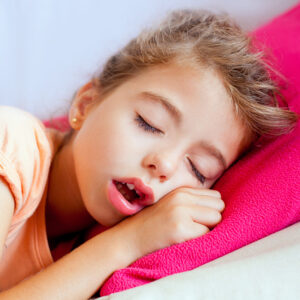Sleep Disordered Breathing & Your Child
 Sleep Disordered Breathing (SDB) is becoming increasingly recognized as a chronic disorder of dysfunctional breathing during sleep. In children, this can range from habitual snoring to OSA and can cause disturbed sleep, low blood oxygen levels, ADD/ADHD, poor academic performance, bed wetting, exhaustion, as well as behavioral, mood, and anxiety disorders. Fortunately, we recently shared with you that Dr. Viernes-Chisler became a Qualified Orofacial Myologist. But what you may not know is that as part of the training required for that designation, she received continuing education through Tufts School of Dental Medicine’s first pediatric dental sleep medicine program. Here’s what that means for our patients and their families!
Sleep Disordered Breathing (SDB) is becoming increasingly recognized as a chronic disorder of dysfunctional breathing during sleep. In children, this can range from habitual snoring to OSA and can cause disturbed sleep, low blood oxygen levels, ADD/ADHD, poor academic performance, bed wetting, exhaustion, as well as behavioral, mood, and anxiety disorders. Fortunately, we recently shared with you that Dr. Viernes-Chisler became a Qualified Orofacial Myologist. But what you may not know is that as part of the training required for that designation, she received continuing education through Tufts School of Dental Medicine’s first pediatric dental sleep medicine program. Here’s what that means for our patients and their families!
Every Detail Dental Kids patient receives an oral airway exam at their dental preventive appointments. During the screening we perform oral airway and dental evaluation to ensure proper development of your child’s speech, swallowing and upper airway. We examine the teeth, lips, tongue, palate, muscles, and temporomandibular joint (TMJ) otherwise known as the mandible (lower jaw) and temporal bone (side and base of the skull). In this screening we are looking for any physical characteristics such as enlarged tonsils, crowded and misaligned teeth, grinding, tooth erosion and insufficient jaw development that can cause upper airway resistance and restricted nasal breathing. Additionally, we may take pictures, models of your child’s teeth, or an X-ray called a cone beam to further assess how much airway volume they have. These steps help us determine if soft tissue such as an elongated soft palate, tonsils, or nasal turbinates necessitate further review by an ENT.
At Detail Dental Kids we want you to know how to help your child develop healthy and beautiful smile. We also want to prevent mouth breathing and tongue postures that may cause malocclusion in the teeth and jaws.
A routine airway exam helps our dentists understand physical factors that can interfere with healthy nasal breathing when the child is awake and asleep. Should this evaluation present evidence such an issue in your child, we can then thoroughly discuss symptoms of sleep disordered breathing and upper airway resistance with you and your child. These symptoms may include mouth breathing, snoring, asthma, allergies, eczema, ADD/ADHD, teeth grinding, dental erosion, frequent awakenings, nightmares, and night terrors.
It is Dr. Sara’s goal to connect what she sees in their cranio-facial development with any problematic symptoms your child may be experiencing. Sometimes the connections indicate further evaluation of your airway by ENTs, sleep medicine physicians, and Myofunctional therapists. With their assistance, we can work to create a care plan to help grow a healthy upper airway. Such solutions may include myofunctional therapy, myofunctional mouth appliances, or orthodontic solutions to assist in healthy jaw and airway development. Whatever the course of treatment, it all begins with early diagnosis and an oral airway evaluation.
Watch the videos below to learn more pediatric restricted airway, mouth breathing, and how we use cone beam to diagnose and plan treatment of Myofunctional Therapy.

 6820 Parkdale Pl., #117 |
6820 Parkdale Pl., #117 |